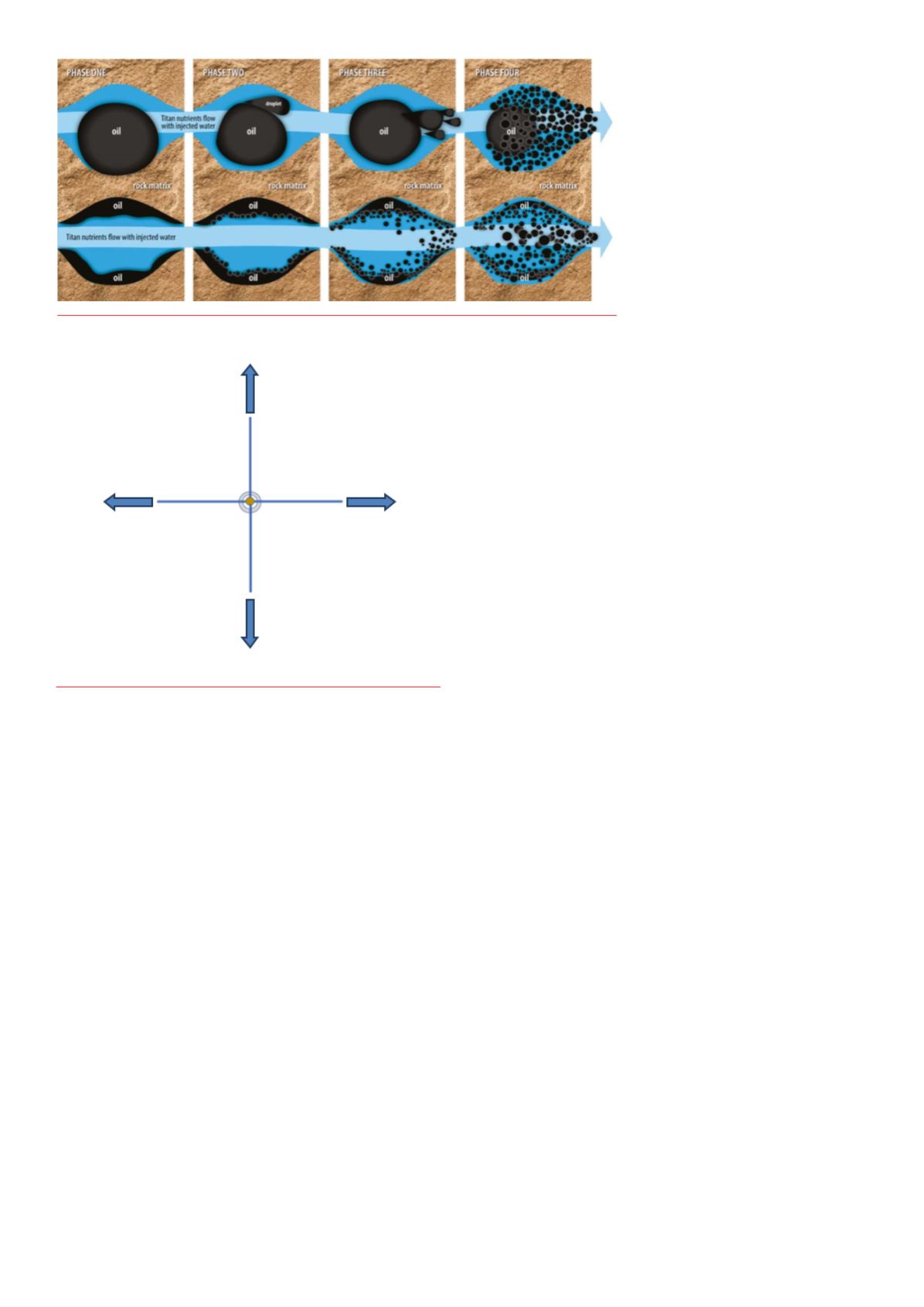
42 |
Oilfield Technology
May/June 2020
Organic Oil Recovery® (OOR) is currently being promoted
by Hunting Energy Services in 23 countries in cooperation with
Titan Oil Recovery. The technology uses tiny micro-organisms to
release oil trapped in reservoirs. These are called microbes, which
are so small a tablespoon of garden soil contains 1 trillion microbes.
Certain species live in the oil reservoirs with no oxygen. OOR
technology allows the microbes to surround oil globules trapped
in the reservoir pore spaces, and deform the droplets into micro oil
droplets so that they can then escape the pore spaces they were
trapped in (Figure 1). This is achieved by sending nutrients into
the reservoir to feed only certain species of microbes. The current
nutrient delivery system used by Titan could be enhanced even
further with smallbore lateral drilling.
The seldom-used smallbore lateral drilling (often referred to as
‘spaghetti string’) technology has yet to find a ‘killer application’
for its different drilling approach. Essentially, it comprises a
small diameter coil tubing enhanced drilling technology that
takes a conventional vertical oil well, places a small diameter
(1 in.) drilling unit downhole and redirects a smallbore hole
horizontally within the pay matrix. This is repeated in four directions
(Figure 2).
One can see from Figure 2 that the communication from the
wellbore to the reservoir fluids consists of a small area along the
wellbore that would be perforated for the length of the zone that
is being accessed. The original low pressure zone is represented
by the small circle where the reservoir
fluids would be flowing towards the
wellbore. With the small lateral holes
now extending out from the wellbore,
four new and considerably extended
low pressure zones have been created,
allowing reservoir fluids to be taken into
the new lateral boreholes.
In the past, the problem with this
drilling technology was that trapped
oil only 1 cm from the new lateral
borehole could not move into the lateral
borehole: it was trapped oil. With the
OOR nutrients (represented by the gold
arrows in Figure 3) now being pushed
out in four directions and in a cone-like
manner, the reservoir matrix – having been saturated with the OOR
nutrients – is increased significantly and that area contains microbes
that should respond to the nutrients and release trapped oil.
Due to the fact that the drill string and cutting tool is so small the
resistance from the rock is consequently reduced. Boring through
rock with 5 – 10 in. dia. drill bits is considerably harder and more
expensive than using a 1 in. dia. drill bit.
The concept behind the spaghetti laterals was to contact oil
away from the wellbore, bypass wellbore damage and create
multiple low pressure zones away from the wellbore. However, as
stated earlier, trapped oil was still a problem. If the small laterals
could be used with the OOR technology and so release trapped
oil, then the delivery system of the OOR nutrients would change
from a one-dimension point outward from the vertical wellbore
perforations to a four-dimensional process extended out horizontally
in four directions from the wellbore (Figure 3 shows the red arrows
extending out in two directions).
Although Titan’s OOR technology is ideal for water-flooded
fields, single well applications with a huff and puff method have
proven successful.
The new lateral holes – by creating new multiple and extended
low pressure zones – could allow for better pore space drainage from
the existing reservoir pressure, combined with the micro oil droplet
effect of the process. Radial drilling can also be applied to injection
wells and offshore.
Considering that 65% of the oil surrounding these wells
is trapped and OOR already releases substantial amounts of
incremental oil, this new delivery system for the process could allow
for even better recovery factors and production volumes in vertical
oil wells.
The OOR technology is an EOR technology that manages the
biology and ecology of an oil reservoir and feeds certain microbial
species a special nutrient package that results in the microbial
species multiplying dramatically, and then creating a phenomenon
that releases trapped oil from the pore space of the reservoir.
The current huff and puff method allows for the OOR nutrients
to be pushed or squeezed out into the formation and for the
microbial reactions to take place in that area. Due to certain physics
and chemical phenomenon, the nutrients diffuse out away from
the wellbore and affect an increased areal matrix. However, if the
nutrients could be displaced even further from the wellbore then a
significantly larger area of the oil-producing zone could be flooded
with the nutrients and this could create an even larger oil production
response (Figure 3).
OOR could be a useful technology in the smallbore (spaghetti
string) lateral drilling industry.
Figure 1.
Simple diagramof howOOR createsmicro oil droplets.
Figure 2.
Small lateral drill holes are nowextended out fromthe
wellbore.








